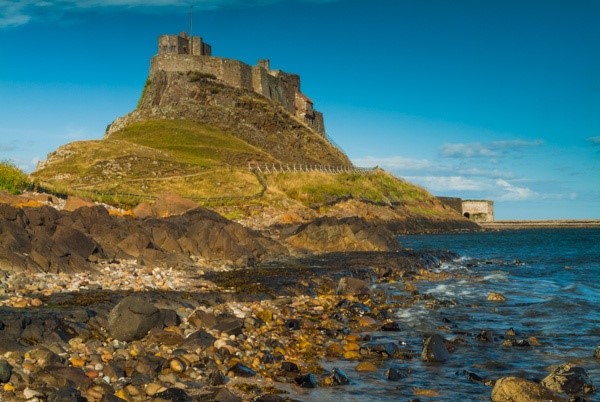
2021 AUTUMN HOLIDAY: LINDISFARNE CASTLE AND THE VILLAGE
Good day readers
Whilst on holiday in Northumberland we went to Lindisfarne. It is quite
a trek up the single carriageway of the A1 up to Beal. The Barn at Beal is also
one of our favorite eating places although the day we went the place was closed
due to staff being off with Covid. We retreated back to the BunkHouse café and
had an excellent second breakfast. Our first breakfast is taken at the self
catering place where we stay and is generally cereals. At home we usually have
toast and marmalade for our second breakfast, although on holiday we usually go
for something cooked.
To get from the mainland to the island is a tarmac road, forming a
causeway, has to be crossed. The causeway is covered by the high tide that
comes in deceptively quickly. The Barn used to have a CCTV showing the causeway
and it was interesting to sit and have breakfast while waiting for the causeway
to clear. Northumberland County Council has a free website giving the safe
crossing times that use can use the causeway. There is a disclaimer that
adverse weather can result in the safe periods being substantially reduced.
HGVs can and do cross the causeway early and late using the advantage
of their greater ground clearance to splash through when it is too deep for a
normal car. We have seen unfortunate motorists on occasion follow a HGV and get
their car stuck (and generally it is a write-off) in the deeper water. More
frequently motorists who have not read the crossing tables go to the island
intending to return later. They are then caught out by one of three
possibilities,
Firstly, they leave it too late and try to race the tide to cross.
Secondly, a southerly wind gets up and floods the causeway very quickly
after the safe crossing time,
Thirdly, they ignore both the tide tables and the warning signs at the
side of the road (If the water reaches this point turn round and do not attempt
to cross).
Any of the three scenarios leading to a stuck motorist, consequently
the coastguard and inshore lifeboat are called to rescue the occupants.
Lindisfarne was a strategic defence point on the coast. The Romans had
a fort and landing place for boats on the island. Later the island was at the
mercy of both the Vikings and the Scots. After the dissolution of the
monasteries (including Lindisfarne Priory) in the early 16th century, the small timber fort near to the Priory was replaced by
a more substantial timber fort on the craggy outcrop of Beblowe Crag. In
the mid 16th century the castle was built using
stone from the Priory. It was captured for a short period during the 18th century by the Jacobites from Scotland but was recaptured and
then manned by troops from Berwick.
In 1901 Sir Edwin Lutyens updated the castle to be a country home, for
a publisher who had bought it, in the style of the Arts and Crafts movement.
We generally plan a morning of our holiday, around the safe crossing
time to Lindisfarne. We park in the carpark, walk into the village and then
complete an hour long circular walk on the island passing the harbour, castle,
a garden designed by Gertrude Jekyll, along the seashore and back across
country to the village. After the walk we went to Lowton and ate lunch at the
Black Bull before returning to Amble.
I have included in this blog a couple of pictures one of the castle and
one looking from the castle to the town. The Barn at Beal and the causeway are
featured in the first book of the intended series.
My first book “Port St James: Cliff farm” is a modern romance set in
Northumberland. The fishing village is overlooked by a medieval castle. The two
principal characters meet on the steps of a solicitor as both of them complete
their respective divorces.
My book was published by Austin Macauley on 31st August 2021and is available on line, from most bookshops and as
an ebook. I hope you enjoy reading it as much as I did writing the novel. If so
please post a review on https://austinmacauley.com/book/port-st-james
Thank you and all the best Philippa

Post Views : 241